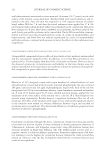DERMAL EFFECTS OF UNSAPONIFIABLE COMPOUNDS 221 cell degranulation (59). In another study on rat skin (60), it was observed that a 1% γ-oryzanol ointment, in contrast to the control ointment, caused the stimulation of seba- ceous glands, which resulted in an increase in sebum production. PHOSPHOLIPIDS P hospholipids a re amphiphilic molecules typically composed of hydrophobic fatty acid “tails” and a hydrophilic phosphate “head.” Physiologically, they are the dominant lipids in cell membranes (61). Lysophosphatidic acid was reported to be benefi cial in wound healing, pruritic skin disease, skin tumors, scleroderma, and skin infl ammation reaction (62). DERMAL EFFECTS OF UNSAPONIFIABLE COMPOUNDS IN VEGETABLE BUTTERS AND OILS The reviewed st udies demonstrate specifi c mechanisms of action of isolated unsaponifi - able compounds such as the antioxidative, anti-infl ammatory, antitumor, immunomodu- latory, and antimicrobial activities wound healing and anti-acne and anti-dermatitis activities, as well as regenerative, hydrating, photoprotective, and anti-wrinkle activities. This provides us basic evidence for the understanding of their general benefi ts when used dermally, either alone or as ingredients in therapeutic and cosmetic formulations. How- ever, it must be clearly emphasized that the results of in vitro and animal in vivo research cannot be directly extrapolated as real effects after application on the human skin. Further, within the concept of this review, special emphasis was placed on studies dealing with total unsaponifi able compounds, particularly as integral structural components of vegetable butters and oils. Presented in the following section is a review of research fo- cused on in vitro tests using skin cell cultures of fi broblasts and keratinocytes, and ex vivo and in vivo tests studying dermal use. UNSAPONIFIABLE COMPOUNDS OF AVOCADO (PERSEA AMERICANA) OIL AND SOYA (GLYCINE MAX) OIL A 5% mixture of unsaponifi able compounds of avocado and soya oils in almond oil, al- mond oil, and 0.9% NaCl, respectively, were dermally applied on rat skin for 15 d (63). Results indicated the improved composition of the dermis, as the proportion of soluble collagen increased signifi cantly. To explain the aforementioned results, the next study (64) by the same research group was designed using additional methods of differential calorimetry, X-ray diffraction, and extensiometry. The tested unsaponifi able compounds improved the biomechanical properties of animal skin, which was demonstrated by an increase in elasticity. UNSAPONIFIABLE COMPOUNDS OF CANOLA (BRASSICA SP.) OIL AND SHEA (VITELLARIA PARADOXA SYN. BUTYROSPERMUM PARKII) BUTTER In a study by L odén et al. (65), the effects of dermally applied substances (canola oil, un- saponifi able compounds of canola oil, sunfl ower oil, borage oil, fi sh oil, petrolatum, water,
JOURNAL OF COSMETIC SCIENCE 222 and hydrocortisone) were tested on seven men and 14 women (22–75 years), on the volar surface of the forearm, using aluminum chambers fi lled with tested substances and at- tached to the skin. First, the skin was exposed to a 14% aqueous solution of sodium lauryl sulfate (SLS) for 7 h, and then the tested substances were applied for 17 h. No pretreatment with sodium dodecyl sulfate was performed on the control arm. Skin areas were examined 24 h later. Shea butter, sunfl ower oil, petrolatum, and water induced very weak, barely perceptible erythema on the control skin. On the SLS-treated skin, transepi- dermal water loss was reduced signifi cantly by canola oil, canola oil unsaponifi ables, and hydrocortisone, and blood fl ow was reduced signifi cantly by canola oil unsaponifi ables and hydrocortisone, compared with exposure to water the effects of other substances were insignifi cant. UNSAPONIFIABLE C OMPOUNDS OF GREEN COFFEE (COFFEA ARABICA) OIL Unsaponifi able c ompounds of green coffee oil were shown to have moderate antimicrobial and low antioxidative properties (66). In addition, in vitro Sun Protection Factor was reported to be 10 times higher than that of the oil (results not shown). However, due to the observed cytotoxicity on keratinocytes and lethality in the brine shrimp assay, the authors stressed that more experiments are needed to evaluate the potential of unsaponifi - able compounds in green coffee oil for dermal use. UNSAPONIFIABLE C OMPOUNDS OF HAZELNUT (CORYLUS AVELLANA) OIL Masson et al. (6 7) designed a study with virgin hazelnut oil, refi ned hazelnut oil, and refi ned hazelnut oil enriched with previously extracted phospholipids the oils contained 286 ppm, only traces and 224 ppm of phospholipids, respectively. Each of the oils was incorporated at 10% in a test emulsion, whereas control emulsion contained no hazelnut oil. A total of 56 women aged 30–45 years, divided into four groups, applied the test emulsions on the volar surface of the forearm twice a day for 28 d. Skin hydration was assessed using corneometry. Results showed a signifi cant hydrating effect for all test emulsions. The effect of the emulsion with virgin oil was statistically signifi cant relative to the emulsion with refi ned oil, whereas differences between virgin and enriched oil emulsions were not signifi cant. The determined differences in hydration properties were therefore attributed to phospholipids. UNSAPONIFIABLE C OMPOUNDS OF PALM (ELAEIS SP.) OIL Crude palm oil o btained through the direct compression of palm fruit mesocarp and the tocotrienol-rich fraction of palm oil were evaluated as dermal permeation enhancers of 5-fl uorouracil, lidocaine, and ibuprofen, respectively, using full-thickness human skin excisions mounted in Franz-type diffusion cells (68). Refi ned palm oil was used as a negative control, as it did not infl uence permeation. Permeation enhancement of all three test substances was the highest for tocotrienol fraction, followed by crude oil and then refi ned oil. However, only the fl ux of ibuprofen from both the tocotrienol fraction and crude oil was signifi cant.
Purchased for the exclusive use of nofirst nolast (unknown) From: SCC Media Library & Resource Center (library.scconline.org)

























































































































